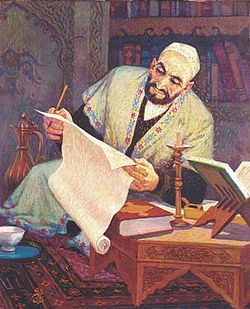- Mahmud al-Kashgari
-
Maḥmūd al-Kāšġarī
محمود الكاشغري

Born 1005
Kashgar, Qara-Khanid KhaqanateDied 1102
Upal, southwest of Kashgar, Qara-Khanid KhaqanateResidence Kashgar Fields Linguistics, Lexicography, Turkology Mahmud ibn Hussayn ibn Muhammad al-Kashgari (Uyghur: مەھمۇد قەشقىرى Mehmud Qeshqiri, Turkish: Kaşgarlı Mahmut, Arabic: محمود بن الحسين بن محمد الكاشغري - Maḥmūd ibnu 'l-Ḥussayn ibn Muḥammad al-Kāšġarī) (Mahmûd Qašqarî) was an 11th century Turkic scholar and lexicographer of Turkic languages from Kashgar.
His father, Hussayn, was the mayor of Barsgan and related to the Qara-Khanid ruling dynasty. His mother, Bibi Rābiy'a al-Basrī, was of Arab origin.
Al-Kashgari studied the Turkic dialects of his time and wrote the first comprehensive dictionary of Turkic languages, the Dīwānu l-Luġat al-Turk (Arabic: "Compendium of the languages of the Turks") in 1072-74.[1] It was intended for use by the Caliphs of Baghdad, the new, Arabic allies of the Turks. Mahmud Kashgari's comprehensive dictionary contains specimens of old Turkic poetry in the typical form of quatrains (Persio-Arabic رباعیات rubāiyāt; Turkish: dörtlük), representing all the principal genres: epic, pastoral, didactic, lyric, and elegiac. His book also included the first known map of the areas inhabited by Turkic peoples. This map is housed at the National Library in Istanbul.[2]
Mahmud al-Kashgari died in 1102 at the age of 97 in Upal, a small city southwest of Kashgar, and was buried there. There is now a mausoleum erected on his gravesite. He is remembered by Uyghurs as a prominent Uyghur scholar.[3]
See also
References
- ^ Kemal H. Karpat, Studies on Turkish Politics and Society:Selected Articles and Essays, (Brill, 2004), 441.
- ^ Roudik, Peter, The History of the Central Asian Republics, (Greenwood Press, 2007), 175.
- ^ But some other Central Asian ethnic groups consider him a member of their group rather than a Uyghur. See, for example, Dwyer, Arienne (2005). The Xinjiang Conflict: Uyghur Identity, Language Policy, and Political Discourse. Political Studies 15. Washington: East-West Center. p. 73. ISBN 1-932728-29-5. http://www.eastwestcenter.org/fileadmin/stored/pdfs/PS015.pdf: "the Uzbeks, Uyghurs, and Kyrgyz all claim Mahmud al-Kashgari, the well-known 11th century scholar, as their own."
External links
Geography and cartography in medieval Islam Geographers 9th century10th centuryIbn Khordadbeh • Ahmad ibn Rustah • Ahmad ibn Fadlan • Abu Zayd al-Balkhi • Abū Muhammad al-Hasan al-Hamdānī • Al-Masudi • Istakhri • Khashkhash Ibn Saeed Ibn Aswad • Ibn Hawqal • Ibn al-Faqih • Al-Muqaddasi11th centuryAbū Rayḥān al-Bīrūnī • Abu Saʿīd Gardēzī • Al-Bakri • Mahmud al-Kashgari12th centuryAl-Zuhri • Muhammad al-Idrisi13th century14th century15th centuryAhmad ibn Mājid16th centuryWorks Schools Balkhi school • Iraqi school
Influences Geography (Ptolemy)Categories:- Uyghurs
- Muslim lexicographers
- Medieval linguists
- 11th-century writers
- 1005 births
- 1102 deaths
- Geographers of medieval Islam
- 11th-century geographers
- Medieval Arab geographers
- Medieval Turkic geographers
Wikimedia Foundation. 2010.

